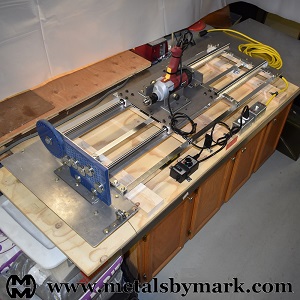
The complete assembly
Categories: Projects and equipment; Jewelry
Word count/read time: 434 words; 2 minutes
This was built for production. As embarrassing
as it looked, the prototype was a successful proof of concept.
The beta version is properly built with metal and plastic.
FRAMEWORK - It is made from square tubing. The lower frame
has lengthwise pieces and the upper has widthwise, all bolted together.
Linear bearing rails are secured in several places to each crossmember.
SLIDING MECHANISM - Linear bearings provide silky smooth movement,
the only logical choice. They can be purchased in any length desired.
Flat bearing rail systems are a magnitude more expensive and less reliable.
MOTOR - A 1/2" reversible,
variable-speed electric drill with a gear reduction motor is the best choice.
Bolts can secure the drill firmly to its mount
courtesy of four threaded holes in the drill body.
POWER CONTROL - Power goes to the master kill switch outlet.
The rheostat, with an integral power switch of its own, is plugged in.
The drill is locked "full on"
and plugged into the rheostat, which now adjusts drill RPM.
BASE PLATE - Metal plate is plenty strong. The four linear bearing blocks
mount underneath it. Angle iron secures the drill on each side and the back.
TENSIONING DEVICE - Highly polished metal U-groove pulleys
keep the wire centered. They are attached to a metal-backed plastic plate.
Numerous holes allow any number of pulleys to be as needed.
WIRE HOLDER - Drill bit depth stoppers anchor the wire to the mandrel. They are
versatile and surefire ($5 for a set).
No more pinching the wire with pliers, forcing
it into the chuck, maiming a mandrel with holes or slots, tying knots, etc.
MANDREL SUPPORT - Erratic coils result when a mandrel flexes
or moves around. Thus, the force exerted by the wire on the mandrel
is concentrated at the support.
Removable discs accommodate mandrels from
1/16" to 1". An adjustable proprietary
system will handle mandrels up to 2".
MANDRELS - DIY store steel rods are inferior, period.
My collection
consists of precision-ground O-1 tool steel drill rod blanks:
3ft long for sizes up to 1/2" diameter (1/64" increments),
2ft long from 33/64" to 1"
(minimum of 1/32" increments), and 1" to 2" are
8" long stainless steel in mostly 1/32" increments.
Myriad micro and nano sizes complete it.
SUMMARY - Dialing it in was slow
since the tolerances had to be tight. At 100 pounds,
it exceeds four feet long by two wide and one tall. Materials were
$500 (not including mandrels). Determining its value is difficult but
I'll make another one w/ free continental USA shipping for $3K. Sweat equity,
or build it yourself.
Posted by M: May 19, 2019
Please email any thoughts or comments regarding this post.
Comment Section
NOTE: Your comments will be included in this section
as long as they aren't illegal. This section is censor-free so show me
your intelligence or ignorance and everything in between!
|
2025
Sell Your Precious Metals
Unusual Request
Check the Pockets
Bracelet Styles
Know What You're Buying
All Knotted Up
Camaraderie
Patina, Pa-tah-no
Tool Maintenance
Fair Competition
Review: Monster Blue Torch
Check the Price
It's Called the Internet
Wax on, Wax off
Aspect Ratio Calculator
Cache Me if You Can
Try, Try, Try Again
Creative Measuring
And the Exceptions Are?
Tools: Use One or Be One
Scales of Justice
Craft Fair Financials
In a Pickle
Weird Silver Items
Stop, and Think
What's a Mentor for?
Organic
Pass the Torch
Four Fs of Jewelry
Those Are Nice Dimples
Yes, I Have Some
Good Deals
Transportaion Issues
Spining in Circles
Top Purchases 2024
2024
2023
2022
2021
2020
2019
2018
2017
2016
2015
2014
|